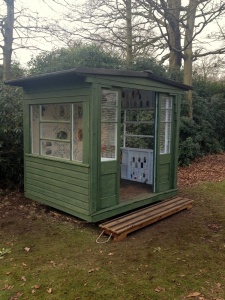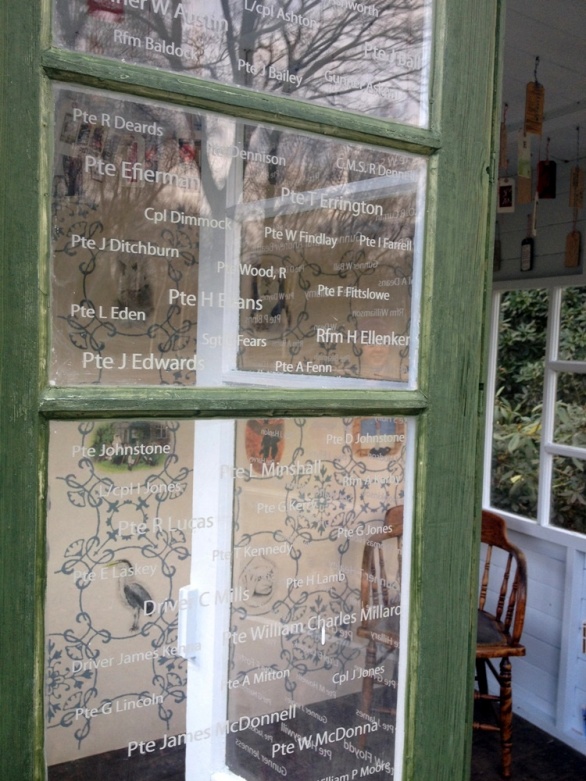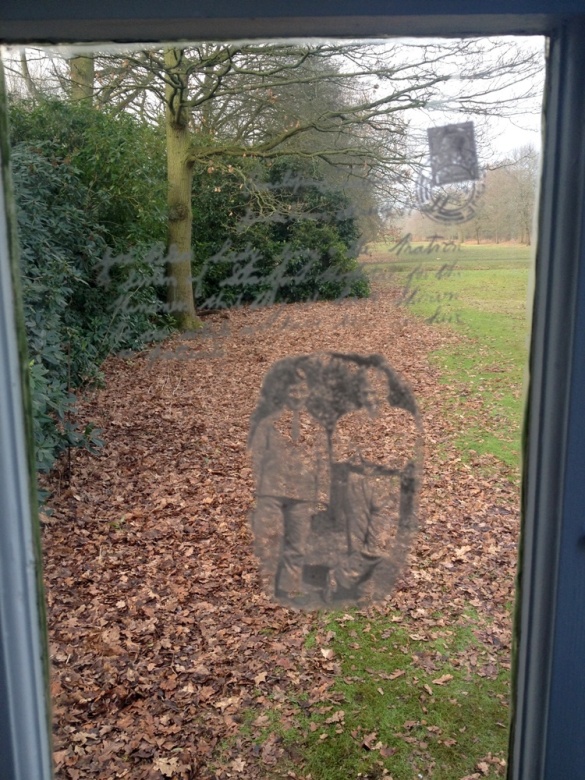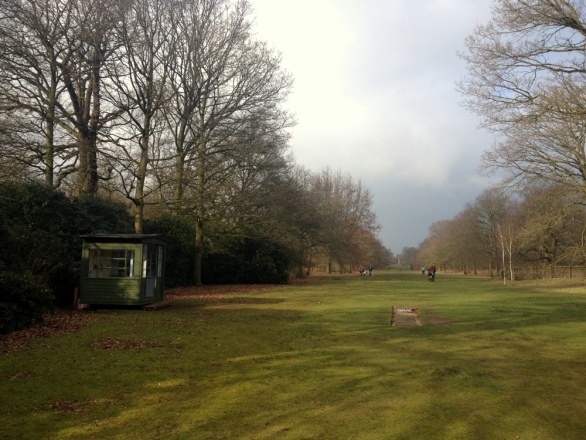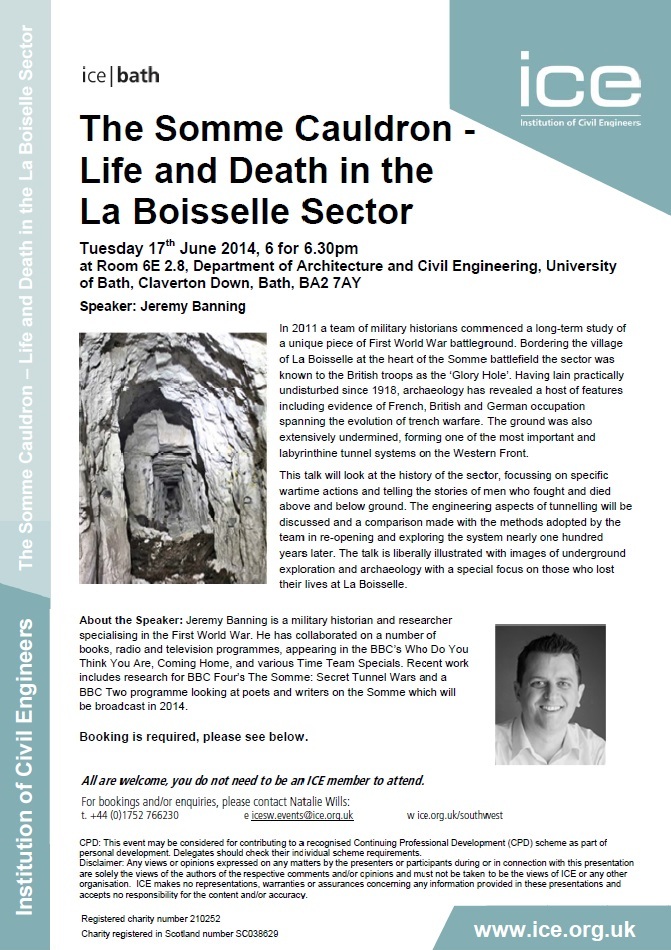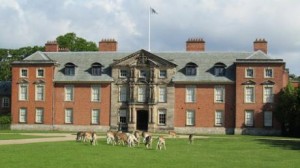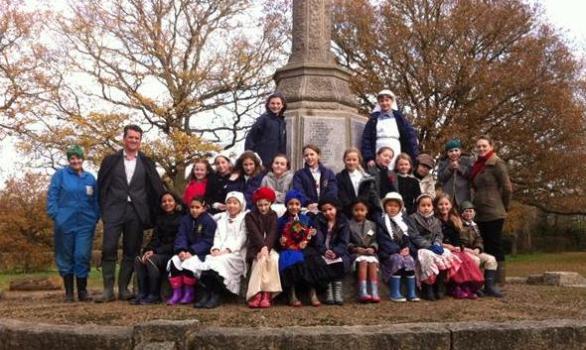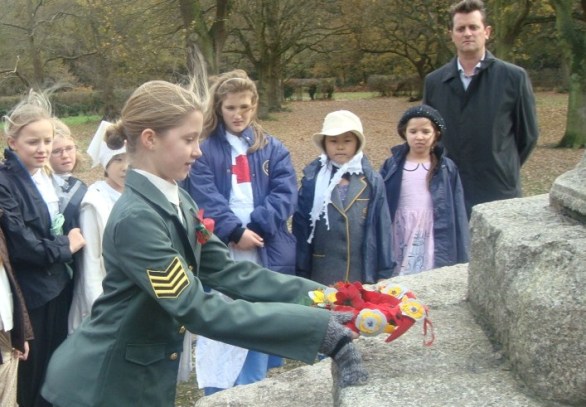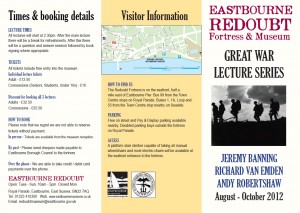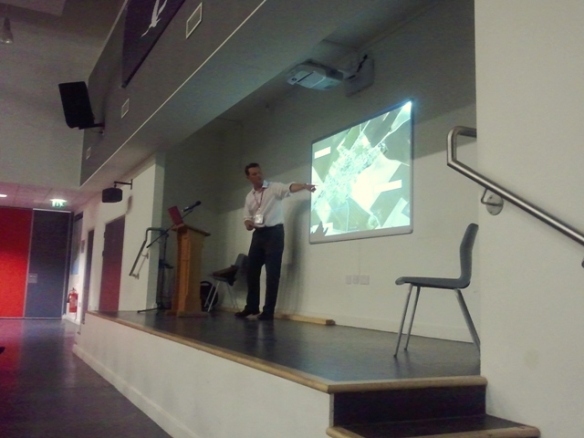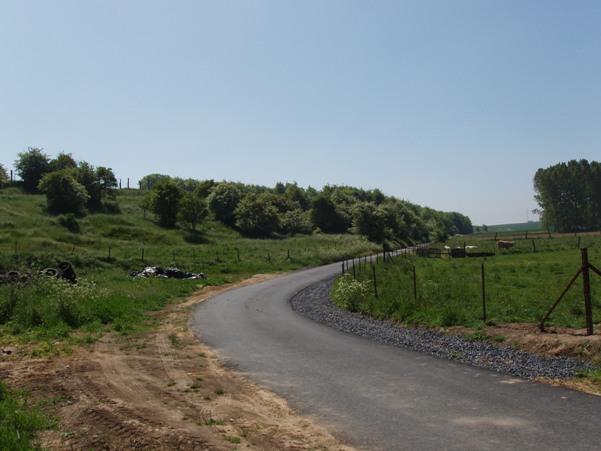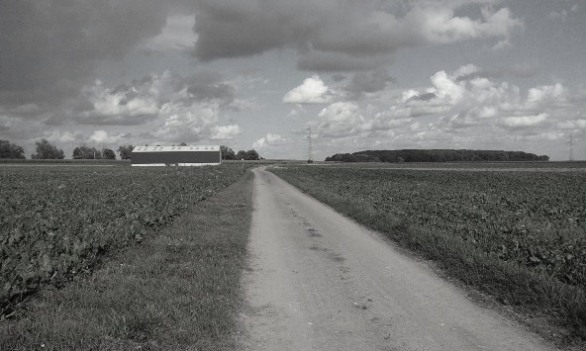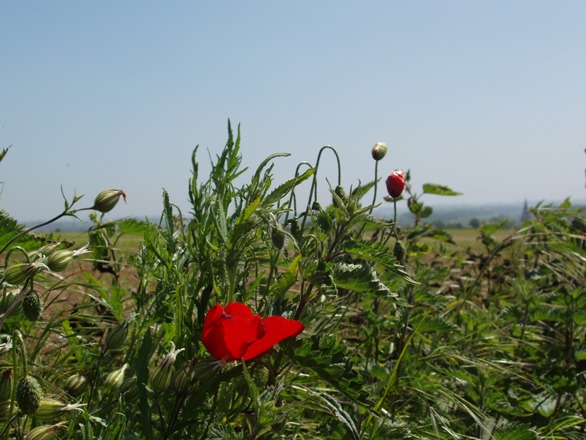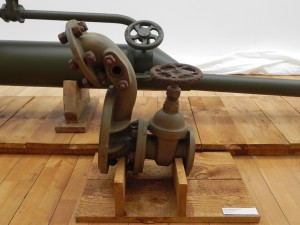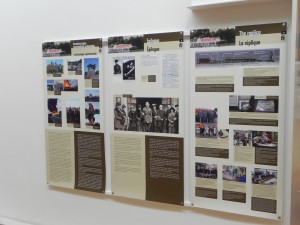Archive for the ‘Talks and lectures’ Category
‘Remembering Reading’s Heroes’ – a talk at Haslams Estate Agents for Reading FC and ABF The Soldiers’ Charity
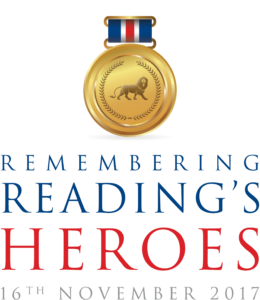
Last week I gave a talk on behalf of Haslams Estate Agents and Reading Football Club in Haslams’ flagship office in Friar Street, Reading. The talk was part of a fundraising evening for ABF The Soldiers’ Charity and was attended by over 80 people.
The evening started with drinks and canapés (based on wartime fare which included such things as spam fritters and Maconochie’s steak pies) before 25 minutes from me discussing Reading in the Great War.

Canapés were based on a wartime theme
Most of the audience had little knowledge of this period of history and I was able to explain some of the more interesting stories I had found in my research. These included the story of Max Seeberg, a former Reading FC player from the 1912–13 season who, by the time was declared in August 1914, had retired and was working as a publican. Despite being a well-known and liked member of Reading’s community his German ancestry ensured he was locked up for the duration of the war. Remarkably, he seemed to bear no malice to Britain, becoming a naturalised British subject in 1920.

Talking about Max Seeburg, a former Reading FC player who was locked up for the duration of the war due to his German nationality
I also spoke about Ronnie Poulton Palmer, the England rugby player, Trooper Fred Potts VC and the tragic case of the Sutton family (of Sutton Seeds) whose five boys went off to war. By the end of March 1918 four of them had been killed, leaving Leonard Sutton (a wartime mayor of Reading) with his sole remaining son, Noel who survived the conflict despite being torpedoed mid-channel by a German U-Boat.
After a break for more drinks and canapés an auction and raffle was held. A weekend on the battlefield with me was auctioned off by local resident, Chris Tarrant. Over £3,000 was raised for ABF The Soldiers’ Charity.
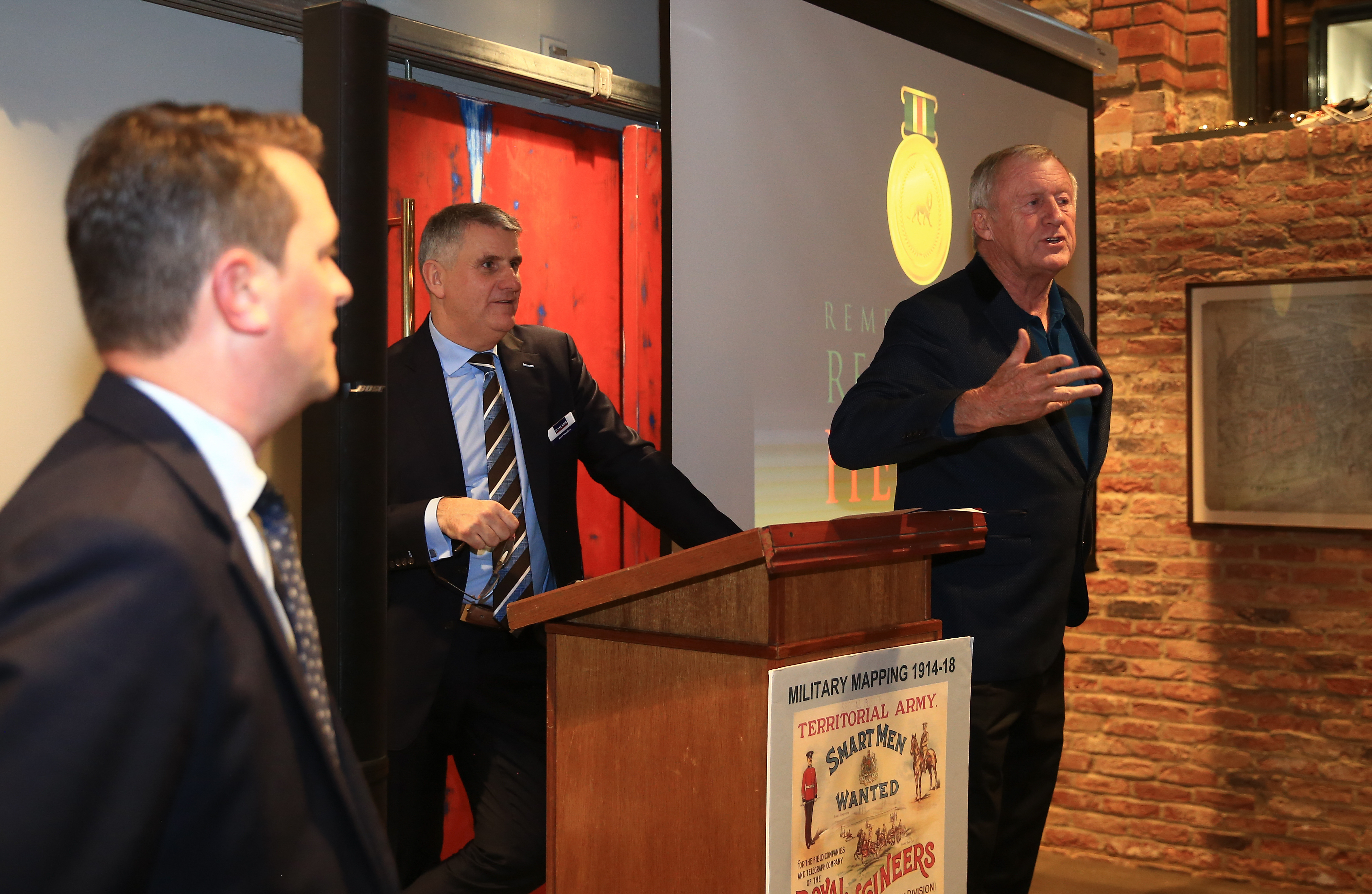
Chris Tarrant auctions a weekend on the battlefield with me to raise funds for ABF The Soldiers’ Charity
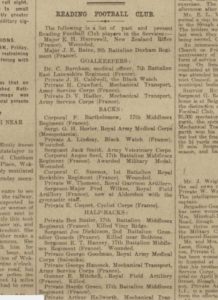
An extract from the Reading Mercury of 12 August 1916 listing players associated with Reading Football Club serving in the forces
The second half of my talk focused on telling the story of a number of Reading FC players and their wartime service. Nine former players died in the conflict whilst others such as Joe ‘Bubbles’ Bailey achieved remarkable success as a fighting officer. In Joe’s case this resulted in the award of the DSO and three Military Crosses, all in a period of just seven months in 1918!
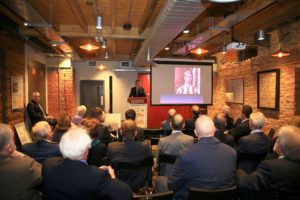
Speaking about Joe Dickenson, ‘the Footballing Grenadier’ who served in the 2nd Grenadier Guards and was killed at the Battle of Festubert in May 1915
My thanks to BBC Radio Berkshire’s Graham McKechnie, military historian Jon Cooksey and Reading FC historian Alan Sedunary who conducted a great deal of research on these players back in 2014.
The entire evening was a great success and I look forward to working with Haslams and Reading FC again in the future.
A selection of images from the evening (courtesy of Ben Hoskins http://www.bhoskins.com/) are shown below.
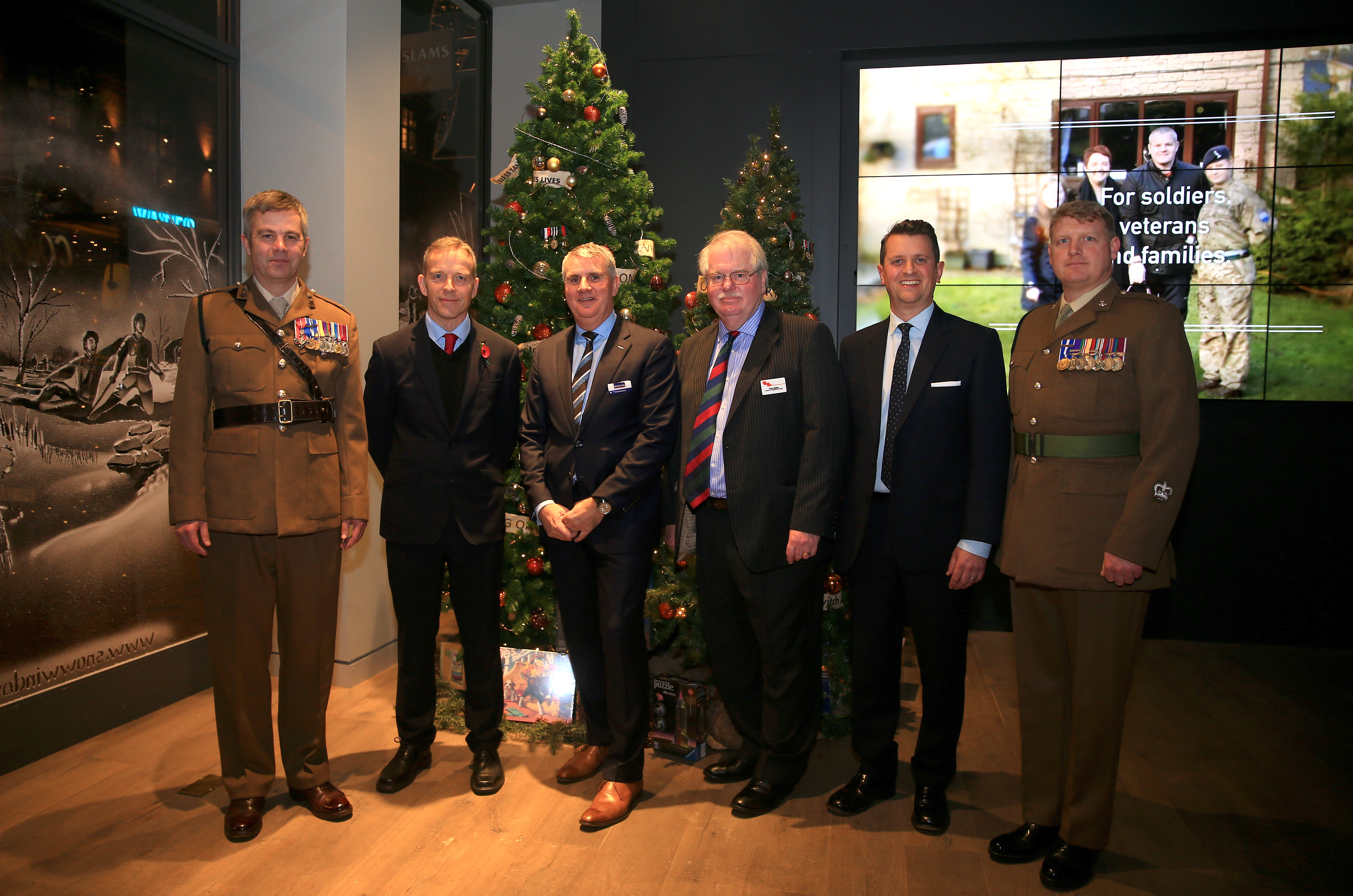
With Steve Woodford of Haslams, Brigadier Peter Walker of ABF The Soldiers Charity and serving soldiers
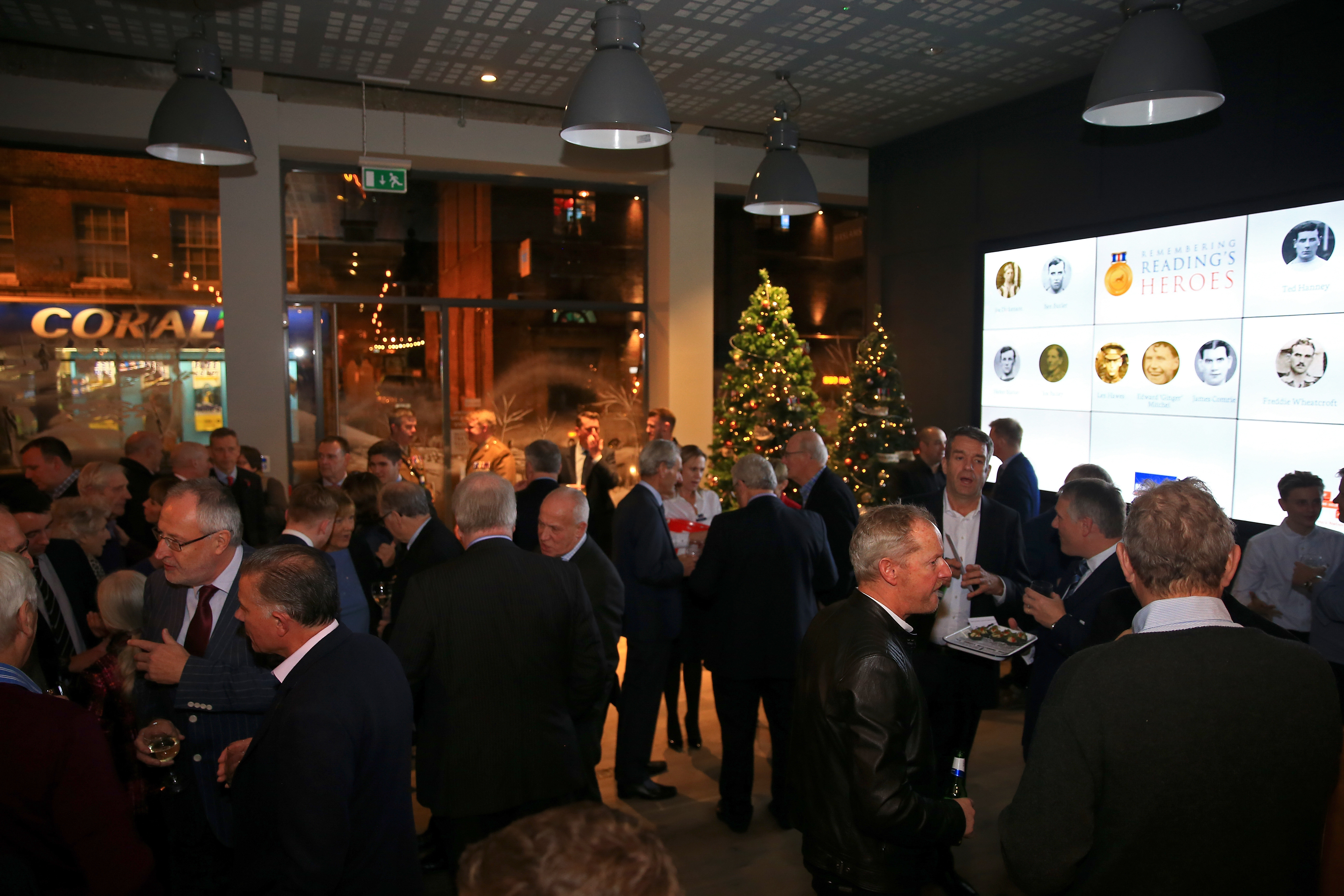
Pre-talk drinks and canapés
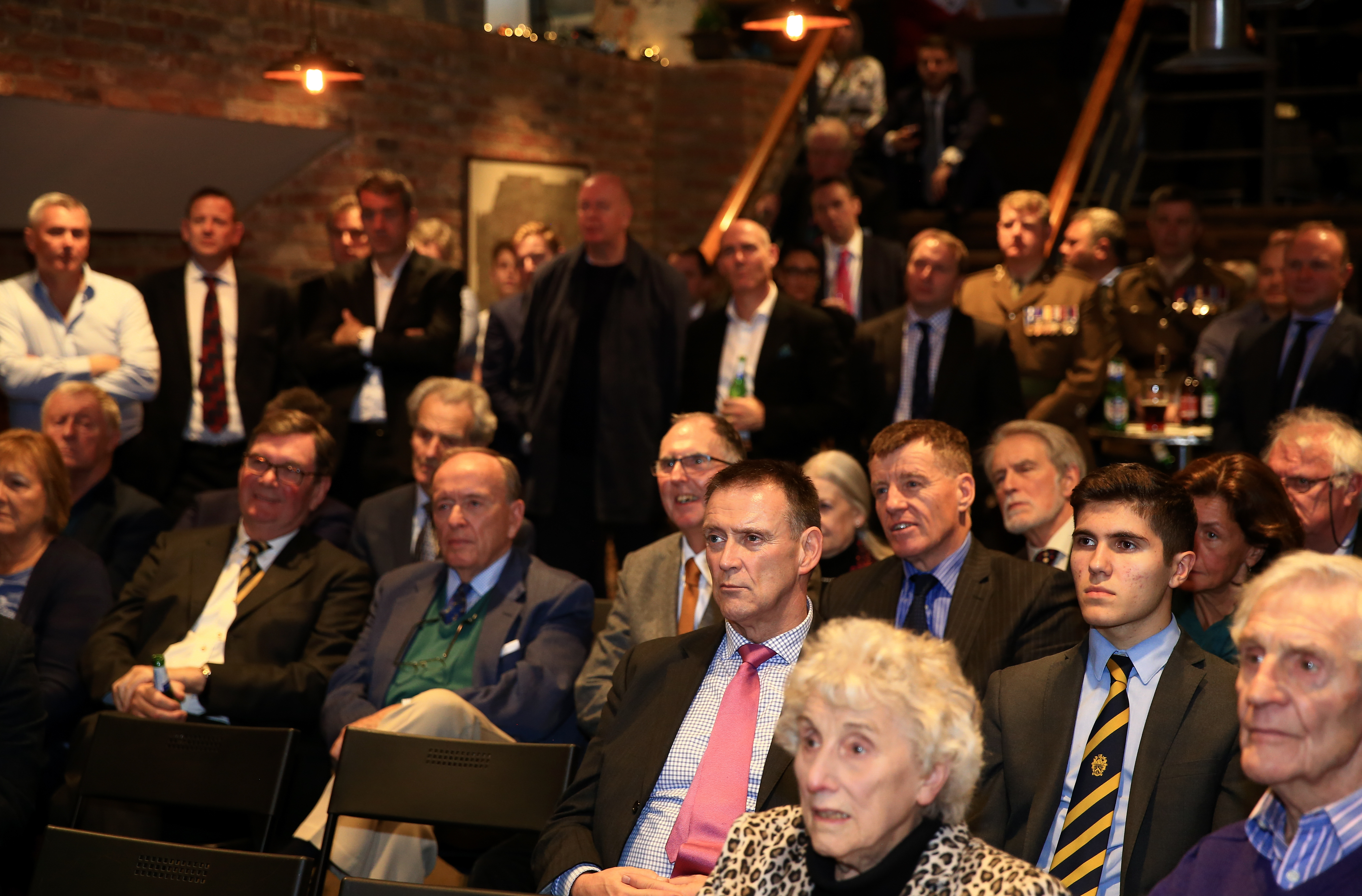
The audience seemed to enjoy the talk
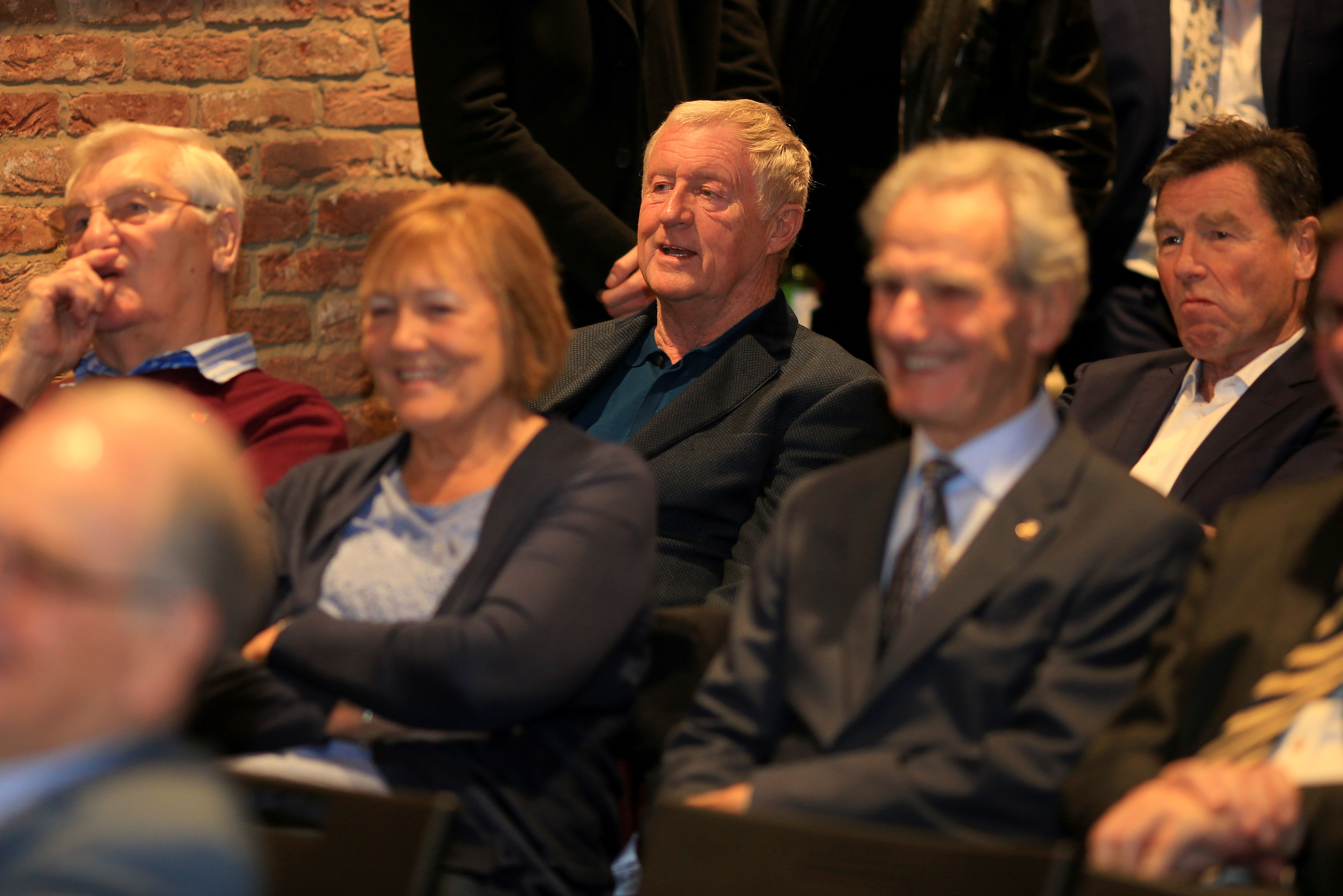
More audience shots
Working with ex-service personnel for ‘The Fresh Air Hut’ at Dunham Massey National Trust
In January I was invited to speak to a group of ex-service personnel who were working with the Military Veterans’ Service. Offering psychological therapy the Military Veterans’ Service provides help to veterans across the North West.
Dunham Massey National Trust’s successful Sanctuary from the Trenches; a Country House at War has recreated the Stamford Military Hospital in the state rooms in Dunham Massey. A doubling of visitor numbers has shown the general public’s interest in the subject. However, for 2015 the staff are keen to showcase further aspects of the medical treatment offered from 1917-19. Sister Bennett, the Hospital’s Matron was a keen advocate of outdoor healing practises. A pivoting wooden hut was situated in the garden at Dunham Massey, which provided sheltered outdoor space for soldiers. A picture in the archive shows wrapped-up patients out in the hut in the snow, receiving ‘fresh air’ and ‘sun bath’ treatments.
Dunham Massey’s ‘The Fresh Air Hut Project’ was designed to involve a team of volunteers working with the Military Veterans’ Service to create an interpretive visitor experience in an authentic replica of the pivoting timber hut. By using art therapy, the ex-service personnel could draw inspiration from their unique training opportunity and reflection upon their own personal experiences of military buy cheap tramadol online life.
I spent a wonderful day with the veterans in early January, speaking about many of the stories of soldiers who had recuperated at Stamford Military Hospital. We were then treated to a tour of the house and able to watch recreations of soldier’s stories; the parts of soldiers and nurses being played by actors. With the information I provided the veterans were able to use parts of the stories in their art workshops. The result of their endeavours, the replica hut filled with artwork, was in situ when the house reopened in mid-February. I visited on the first day, 14 February, and was struck not only by the skill and variety of the artwork but the sense of calmness and solitude the hut offered. Tucked away from view, it felt as if one had stumbled across the hut. Windows etched with the names of soldier patients added to the overall feeling. My congratulations to the veterans who produced such brilliant work and thanks to the personnel who planned and worked with them on this.
Dunham Massey details via the National Trust website: http://www.nationaltrust.org.uk/dunham-massey/
On Tuesday 17 June I will be speaking on “The Somme Cauldron – Life and Death in the La Boisselle Sector” at the Institute of Civil Engineering, University of Bath. Doors open at 6.00pm for a 6.30pm lecture start.
Full details can be found on the attached PDF flyer. Please click to open and download: Univeristy of Bath Flyer
Tickets are free – but limited in number – so please book ahead to ensure your attendance.
Earlier this autumn I spoke to the staff and volunteers at Dunham Massey Hall, a National Trust property in Cheshire. I had been approached some months before to help with their ambitious First World War project ‘Sanctuary from the Trenches’ which will see the hall will open its doors on 1 March 2014 as Stamford Military Hospital, the convalescent hospital in which 281 soldiers were treated between April 1917 and January 1919. Lady Stamford’s original plan to turn the hall over for use as a hospital for officers was altered, perhaps due to the sheer number of wounded men, and when the doors opened in April 1917 the hospital cared solely for ‘Other Ranks’.
My role in this project was to interpret the wealth of material gathered by the team of volunteers, pick a representative sample of men from those chosen and use their stories in a lecture to not only explain the conduct of the war in 1917-18 but also elaborate on the daily routine of trench warfare, evacuation of sick and wounded and medical treatment received by the men. The information uncovered by volunteers was prodigious; there was no shortage of material related to the soldiers’ stay at Stamford Military Hospital. What was lacking was an appreciation of where those men had come from, in what actions they had fought and been wounded and what happened to them after their recuperation.
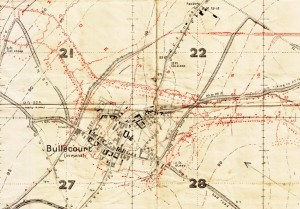
Bullecourt trench map extract. Two of the men who recuperated at Stamford Military Hospital were wounded here on 3 May 1917.
Casualties studied included a man of the 11th Rifle Brigade wounded near Havrincourt Wood in the push to the Hindenburg Line in early April 197, two men caught up in the Hindenburg Line itself at Bullecourt in May and a French Canadian wounded on Vimy Ridge. I was also able to use descriptions from my research into the Battle of Arras to illustrate the actions at Fampoux and Roeux in which a soldier of the 2nd Duke of Wellington’s (West Riding) Regiment was badly injured. Moving northwards to Flanders I was able to look at the Battle of Messines (June 1917) with Private John Ditchburn, 9th Yorkshire Regiment, wounded close to Hill 60 on 7 June and two further casualties from the Third Battle of Ypres. Sources used included Medal Index Cards, Service Records (where available) and Census Returns. By scouring Brigade, Division and Corps files I was able to find appropriate maps to illustrate the exact area where the men had fought.

War Diary extract from 2nd Duke of Wellington’s (West Riding Regiment) for October 1917. One of the men who had been wounded at Arras, recuperated at Stamford Military Hospital, returned to the front and was killed in the Passchendaele offensive.
I was also keen to include soldiers wounded whilst not taking part in any major set-piece battle but in the daily business of merely ‘holding the line’. This offered a good opportunity to show the limitations of available documents. None of the men I researched were named in unit war diaries and so, in many cases, it was an educated guess as to the site of his wounding. Private William Johnstone, 1st Gordon Highlanders was hit by shrapnel in spring 1918 close to the city of Arras but from sources available I was unable to identity which day. His was a particularly sad story; after recuperating for over two months at Dunham Massey he was found to have shrapnel embedded deep in his head. Over time his condition deteriorated and he died of a cerebral abscess in hospital in Manchester. The final man I focussed on was even harder to research; Private Jenkins of the 1st Gloucestershire Regiment was wounded at some point during the autumn of 1918, the ‘Last Hundred Days’ of the war. His full identity remains unknown with neither christian name or regimental number noted in the records extant. I was keen to contrast this with some of the earlier soldiers I had researched where I had been able to provide highly detailed information.
Having prepared the research on these men I spoke at Dunham Massey Village Hall to two groups of volunteers on 18 September. I was heartened by the audience’s reaction, not only by the enthusiasm shown but also the interest in the men and the ‘Sanctuary from the Trenches’ project. I look forward to returning to Dunham Massey to see how the information has been used and what the ornate saloon will look like with furniture replaced with stark hospital beds. I would like to thank Charlotte Smithson and all those who work and volunteer at Dunham Massey for their help and enthusiasm with this project.
Our forthcoming project Sanctuary from the Trenches; a Country House at War tells the story of how Dunham Massey Hall became the Stamford Military Hospital, caring for 281 soldiers. Our collection gives us some information about the soldiers that stayed at Dunham, but we wanted to know more about their lives before they were treated here. Using our archive and other resources, Jeremy pieced together their stories. Jeremy’s respect for those that fought during the First World War made for a heart-warming lecture. He talked us through what our soldiers had experienced and left us feeling fondly affectionate for the brave souls who were cared for here. Over 100 volunteers attended the lecture and it was a big hit with them all – they haven’t stopped talking about it since. It provided the background of information for our volunteers needed in order to contextualise the Stamford Military Hospital’s role in the First World War. We’ll be asking Jeremy back, without a doubt!
Charlotte Smithson, Volunteer Development Manager at Dunham Massey
An interview with me discussing my research is available to view below:
For those interested my lecture is available in full here: http://vimeo.com/75168130
A dedicated page on the National Trust’s website with further details is available here: Sanctuary from the Trenches http://www.nationaltrust.org.uk/article-1355804816003/
Further testimonials:
‘Jeremy Banning’s knowledge of the First World War is second to none and he is as good a presenter as you could wish for. A star attraction, I would suggest. So to have him come to talk to us Volunteers was a real treat. The presentation was so revealing and full of fascinating tales of soldiers directly connected to our Property’.
‘I am still buzzing and it is down to Jeremy Banning! Such a wonderful talk – please pass on my thanks.’
‘I want to thank you for enabling me to have and enjoy the privilege of attending Jeremy Banning’s presentation this morning. The whole experience was informative, exciting, thought provoking, uplifting and at the same time humbling. Jeremy’s enthusiasm and knowledge, for me and I am sure, all the other volunteers attending, made it a most memorable morning and I thank you, very sincerely, once again.’
‘A superb morning at Dunham Village Hall with Jeremy Banning – he really brought our soldiers to life, with such affection too. It was a privilege to attend’
On Saturday 19 October I will be speaking about the ‘The Battle of Arras – April/May 1917’ at the autumn seminar of the Worcestershire & Herefordshire Branch Western Front Association. The event will be held at the University of Worcester, Henwick Grove, Worcester, WR2 6AJ. Doors open at 12.00pm with my lecture starting at 1.00pm. Richard van Emden will be speaking at 3.15pm on ‘Boy Soldiers of the Great War’. Full details can be found on the attached PDF flyer. Please click to open and download: Worcestershire & Herefordshire WFA Seminar poster
Copies of ‘Arras – The Spring 1917 Offensive in Panoramas including Vimy Ridge and Bullecourt’ and Richard’s ‘Boy Soldiers of the Great War’ will be available to buy.
To buy tickets please call the Worcestershire & Herefordshire Branch on 01905 774797 or e-mail whb.wfa@hotmail.co.uk. The deadline for bookings has now been extended to 4 October.
School workshop at Putney Park School
On 22 November I gave a workshop at Putney Park School in south west London. It was a fascinating day speaking to children ranging in age from six to fourteen. The morning was devoted to Juniors who had got into the swing of things by dressing in Great War era clothes for the day. One girl was wearing a genuine nurse’s outfit from the time. The day started with an hour’s talk on what it was like to be an infantry soldier, why men enlisted and how they did so, information on their training and then an hour-by-hour breakdown of a typical 24 hour period spent in the trenches.
After a tea break we boarded a coach that took us to the nearby Richardson Evans Memorial Playing Fields War Memorial, situated in a five-acre area of landscaped ground. It commemorates men with Putney and Wimbledon connections; in consequence the memorial has many names. The children looked at these and I pointed out men with decorations (three Victoria Cross recipients alone) and those with the same surname; sadly the memorial contains many sets of brothers. The trip was based on trying to encourage the children to see not just a list of names but that every individual had a story whose death had left a loved one heartbroken and bereft. After laying a specially (and rather lovingly) crafted wreath followed by a minutes silence and the Exhortation we returned to school.
I was then able to provide details on some of the men listed on the memorial including Zeebrugge Raid hero, Lt Commander Arthur Harrison VC. I had found one local family, the Nottingham’s, who had lost three brothers in the space of a year. Interestingly, each brother had fought in a different unit or service. I traced the family back to the 1881 census and was able to show how the family moved around and grew – there were seven children in total – before the war claimed the lives of three. The first to be killed was Leslie, a Gunner in the Royal Marine Artillery who was serving on HMS Queen Mary when it was lost at Jutland on 31 May 1916. The next boy lost was Arthur, a Sergeant in the 3rd Battalion Canadian Infantry. He had emigrated to Canada before the war in search of work and, like so many other British in Canada at the start of war, had enlisted in the Canadian Army. He was badly wounded on the Somme on 9 September and two weeks later succumbed to his wounds, being buried in Wandsworth (Earlsfield) Cemetery. The final boy to die was Ernest, the eldest of the family and a decorated sergeant in the Civil Service Rifles. He was killed on 10 June 1917. Using archival material I was able to show details of the brother’s service and, where possible, mention of them by name in battalion war diaries.
I finished my talk by speaking about Private Alfred Whittle, 10th Battalion Sherwood Foresters who was killed outside Ypres just after Christmas 1915. What made him special to the children was the fact that the CWGC recorded his daughter Alice lived at 7, Woodborough Road in Putney – part of what is now the school complex. I hoped that by picking specific names and elaborating on their story the children would realise that the list of names were once living, breathing human beings with families that loved them and mourned their passing.
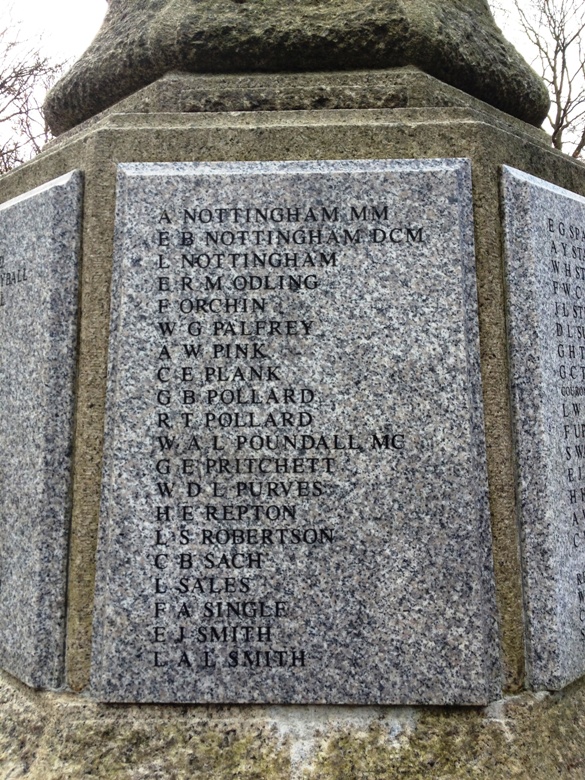
The three 'Nottingham' brothers on the Richardson Evans Memorial Playing Fields War Memorial. Arthur, Ernest & Leslie all died within a year of each other.
After lunch I spoke to Year 1 children about the census and what sort of things are recorded before finishing off with an hour’s lecture to Year 9 students on the life of an infantry soldier. My thanks to Mrs Wright for arranging the day, staff members for their welcome and the children for their enthusiasm and interest.
“Jeremy’s knowledge, professionalism, charisma and palpable enthusiasm for everything to do with World War 1 not only brought the topic alive for my students but changed the lives of many of us. In such a short time we fully understood trench warfare and the impact on families and nations. From the first time I made contact with Jeremy he responded quickly to my queries, offered fantastic ideas and prepared very well for the day. I simply would not teach the topic again without him.
In addition, after his visit I had enough material for the next four weeks for class work. The children steered their parents to find out more about their relatives using the strategies Jeremy taught. One has since visited the National Archives, read about her great grandfather in the war diaries and then researched the three battles he fought in, all of which Jeremy had mentioned. Another pupil researched her great grandfather by emailing relatives and was proud to bring in a number of items from his uniform and life. Jeremy’s idea of visiting a memorial and researching some of the names on there really brought it home to the children and I know that on Armistice Day, and probably every day, my children will really be remembering our men. Jeremy spent the morning with our year 5s and 6s and then did two wonderful presentations to year one and nine. I cannot recommend him highly enough.”
Mrs J. Wright, Head of Junior School, Putney Park School
On Saturday 18 August I will be the first speaker of the Eastbourne Redoubt Fortress & Museum Great War lecture series. My lecture “Somme Archaeology: The Glory Hole and the work of the La Boisselle Study Group” begins at 2.30pm. Ticket prices are £12.50 (Adult) with a concession price of £10 for Senior Citizens, Students and Under 16s.
Further details can be found here: http://www.eastbournemuseums.co.uk/Events.htm
Other speakers for September and October are my good friend Richard van Emden and Curator of the RLC Museum, Andy Robertshaw.
The lecture will showcase the work undertaken since June 2011, giving a history of French, German and British warfare (surface and subterranean) at La Boisselle from 1914-1916. I will also include many images previously unseen showing British tunnels dug in September-October 1915.
A pdf document with details of all three talks can be downloaded by clicking on the image below.
On 13 June I gave a talk to 65 students and staff at South Bromsgrove High School on the work of the La Boisselle Study Group. Soon after media coverage began on our work in June 2010 I was contacted by James Wilson from the History department who was keen to learn more and, if possible, visit the site on the annual school battlefield trip.
My talk focussed on our current archaeological work as well as the wartime history of the site. It was satisfying to be given the opportunity to do justice to the resolute French fighting for the village and Granathof in 1914/15. French efforts on the field of battle are often overlooked, something that we are seeking to redress at La Boisselle. I went on to talk about the handover to British troops in summer 1915 and their subsequent efforts, both above and below ground.
Your talk was very well received by both staff and students alike, indeed some of the students have come to find me this morning to ask if we can arrange to come and volunteer at the site; a definite sign that the talk was delivered at the right level. I have to say that it was absolutely what we were looking for, it both enthused and moved the audience through the personal stories you used throughout. I would personally recommend your lecture to anyone who has a interest in the La Boisselle area, or indeed anyone who has an interest in history, a truly captivating talk by an inspirational historian! Mr James Wilson, History Teacher, South Bromsgrove High School
Sadly, this year it was impossible to show the school’s battlefield trip around the site but we aim to do so next year. I have also been asked back to the school to speak next year and look forward to visiting again. My thanks to James Wilson and his colleagues for their generous welcome and feedback. Many thanks to the students for their faultless attention. As a firm believer in the power of education it was immensely rewarding to be able to share my experiences of La Boisselle to school students.
Should you be interested in having me talk at your school or group then please contact me directly.
Having just returned from three days in Arras where I gave a lecture at the Carrière Wellington about the Battle of Arras (April-May 1917) I am heartened by the increase in interest shown in the spring offensive. There is even a plan to tweet updates from the battle which should appeal to those using social media. I thought it a good opportunity to write a short article on the first stage of the battle – the First Battle of the Scarpe which ran from 9 – 14 April 1917. If time and work permits I will do the same for the Second (23/24 April) and Third (3 May) Battles of the Scarpe.
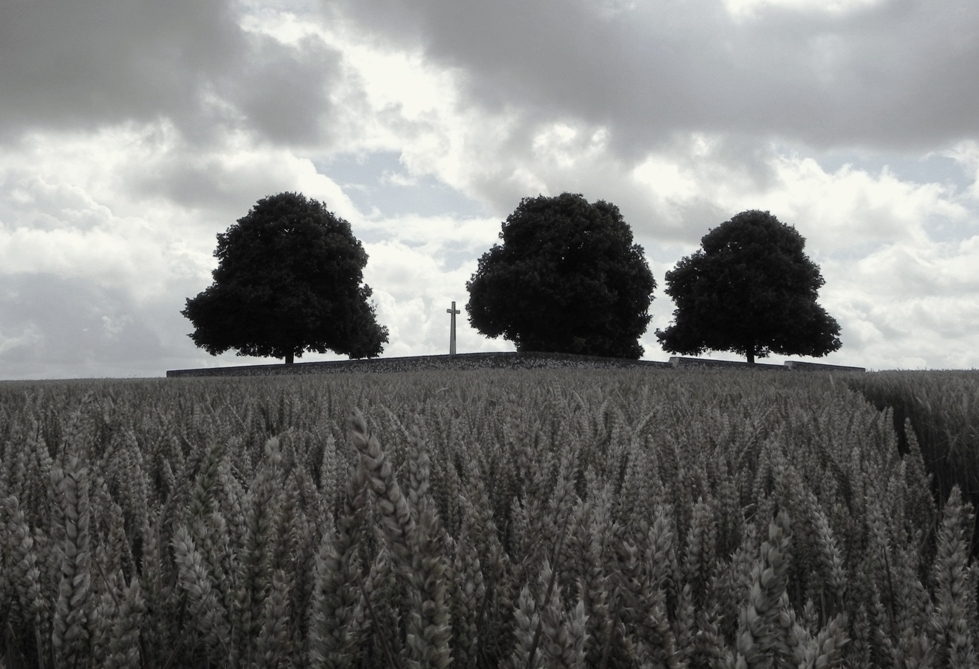
The view from the British trenches at Roclincourt. Highland Cemetery now sits on the position of the German front line. The line was assaulted on the morning of 9 April 1917 by units from the 51st (Highland) Division.
Introduction
Easter Monday, 9 April 1917 was a momentous day which saw the start of the Battle of Arras. It is best known in Canada for the attack and capture by all four Canadian Divisions (operating together as the Canadian Corps) of the previously unconquered heights of Vimy Ridge. It must be remembered that this action, whilst quite rightly lauded was undertaken to protect the northern flank of the main Arras battle front. Sadly, and almost inexplicably the main effort by troops of General Sir Edmund Allenby’s Third Army have been largely neglected by historians, television documentary producers and British battlefield visitors who all head north to Flanders and the blood-soaked fields around Ypres or south to the Somme. I cannot understand this omission as to me, Arras is the most interesting battle of the war offering a major element in the evolution of warfare. By the end of the offensive I would argue that, to many, the prospect of a final victory almost disappears from the Allies’ view.
The British attacks at Arras were part of a larger Anglo-French offensive planned for spring 1917. The author of this scheme was General Robert Nivelle, commander-in-chief of the French armies on the Western Front, who proposed three separate attacks. Two of these astride the Rivers Aisne and Oise would be French led. Great Britain, as the junior partner in the alliance was to launch a major diversionary attack in the north around Arras. It was not what Sir Douglas Haig, commander-in-chief of the British forces wanted, but faced with such a huge French effort there was no other choice but to accept. The German retreat to the pre-prepared positions of the Hindenburg Line (Siegfried Stellung) rendered the attack on the Oise redundant. However, the major offensive on the Aisne and the British diversion at Arras would still go ahead as planned.
9 April 1917 – the opening day
Easter Monday, 9 April 1917 was, in the main, a great success for the attacking British and Canadian forces. Despite the unseasonal sleet, snow and severe cold the Canadian Corps captured the vast majority of Vimy Ridge and British advances to the south were also impressive. An advance of over three and a half miles was achieved by the 9th (Scottish) Division and the ‘leapfrogging’ 4th Division who captured the village of Fampoux. This advance was the longest made in a single day by any belligerent from static trenches.
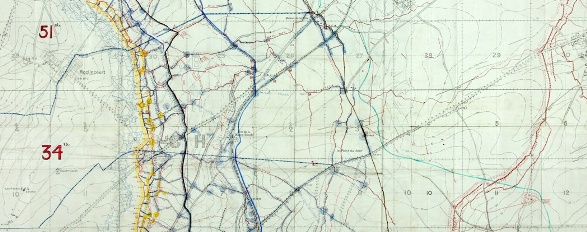
An extract from XVII Corps battle plan showing objectives for the 34th Division including the Point du Jour. Ref: WO153/225. Copyright National Archives & reproduced with their permission.
South of the river attacking British divisions also fared well with Observation Ridge and Battery Valley captured. However, the planned capture of the village of Monchy-le-Preux on its hilltop plateau and Guémappe were not realised. Moving south of the Arras-Cambrai road the successful capture of The Harp and Telegraph Hill can also be viewed as particular triumphs. However, south of the Roman road the British were now attacking the newly constructed Siegfried Stellung (known to the British as the Hindenburg Line). The intelligent siting and design of the Hindenburg Line, coupled with the inability of British artillery to destroy barbed wire sufficiently made the attacks in the south a costlier and much more difficult task. Neuville Vitasse was captured but the two divisions to the south of the village suffered grievously in their attacks.
The night of 9 April saw Germany’s fate in the balance. If British success could be exploited then it was very possible a potentially disastrous breach in their line could lead to a full-scale German retreat. Sadly, for the British, the success of 9 April was the zenith of their action at Arras. Disorganization, breakdown of communications, dreadful weather and the perennial problem of moving the artillery forward over heavily bombarded ground resulted in little concentrated action taking place on 10 April. This delay was exactly what the Germans needed – time to reorganize and strengthen their defences.
First Battle of Bullecourt
The next day, 11 April was a pivotal day of fighting. General Sir Hubert Gough’s Fifth Army attacked in the south at Bullecourt. The hastily constructed plan has been to use tanks of the Heavy Branch Machine Gun Corps to crush the thick belts of barbed wire protecting the Hindenburg Line. When these failed to arrive on time Australian troops broke through the wire, fighting their way into the Hindenburg Line. By midday they were faced with the Germans closing in on them on three sides and were forced to retreat across No Man’s Land to their own line. Over 2,000 men were taken prisoner – the largest number of Australians captured in the war.
The Capture of Monchy-le-Preux
The day also saw the capture of Monchy-le-Preux by the infantry of the 15th and 37th Divisions, aided by six tanks. The capture of the village was an unbelievable feat of arms. Astonishingly, many of the attackers had lain out in the cold and snow for two days and it is a credit to their training and the fighting determination of the British Army that their attacks were pressed with such resilience. Despite the undoubted success of the infantry it is the the fate of the cavalry that Monchy has become synonymous with. With the village captured the cavalry were to advance east to the Green Line. However, they were forced back into the village by German machine gun fire where they were subjected to a ‘box barrage’ of artillery. Unable to escape, the narrow streets were clogged with horses and cavalrymen. The latter dismounted; seeking refuge in cellars but the horses could do nothing and were killed in great numbers as shells rained down. The streets of Monchy, full of horse carcasses and the foul residue of high explosive shells and animals are said to have run with blood.
Disaster for the Seaforths
An ominous taste of things for the future conduct of the battle to come was the attack by the 4th Division on the Green Line from Fampoux. At midday the 2nd Seaforth Highlanders and 1st Royal Irish Fusiliers attacked from the sunken lane between Fampoux and Gavrelle . They were spotted whilst forming up by the enemy in Roeux and on the railway embankment and subjected to shellfire. At zero hour, as they advanced over a kilometre of open ground behind a feeble artillery barrage they were hit by heavy machine gun fire from the railway embankment and Chemical Works. The Seaforths attacked with 12 officers and 420 men and suffered casualties of all 12 officers and 363 men. Only 57 men survived this attack unwounded. This action and the casualties from other battalions of Seaforths are commemorated with the Seaforths Cross at Fampoux. Subsequent attacks were similarly costly. Roeux was fast earning a reputation as a fortress village. British attacks were badly planned and not supported by sufficient artillery fire whilst German defences grew in strength.
13 April was a day for fresh troops to take the field in order to carry on the attack. Exhausted and frozen men trudged back to Arras, replaced by units at full strength. By now it was almost definitely too late for the breakthrough that had appeared so possible on the evening of 9 April.
Infantry Hill – the destruction of the Essex Regiment & Newfoundlanders
An attack was planned from the precarious Monchy salient. Just two battalions of men would attack up Hill 100 (named Infantry Hill by the British). Conditions were so bad in the village with the detritus from horse carcasses blocking the narrow roads that the attack was postponed until 5.30 a.m. on 14 April. The plan was to capture Infantry Hill and send out patrols into the Bois du Sart and Bois du Vert to check for enemy. In hindsight this badly planned attack appears highly dangerous, almost suicidal. The Monchy salient was already surrounded on three sides by enemy forces. The attack, carried out by the 1st Essex Regiment and Newfoundland Regiment went in as prescribed. It started well and by 7.00 a.m. it was reported that Infantry Hill had been captured. However, in their first proper use of the new defensive employment of ‘elastic defence’ a German counter attack was delivered with such speed and precision that over 1000 Essex and Newfoundlanders were killed, wounded or taken prisoner. Monchy had been left undefended and was now at the mercy of advancing Germans troops. The situation was only saved by the commander of the Newfoundland Regiment, Colonel James Forbes Robertson who, with eight other men opened rifle fire from the edge of the village. For five hours their fire held back the enemy until fresh troops reached them. These men, known as the ‘Men who saved Monchy’ were all decorated for this action.
It is not the purpose of this brief article to mention every stage of the fighting but to merely pick out some of the more well-known points. Fighting continued on the Wancourt Ridge with the British capture of the remains of Wancourt Tower. Bitter fighting also continued in the Hindenburg Line; the most well-known casualty from these actions was war poet and officer on the 2nd Royal Welsh Fusiliers, Siegfried Sassoon who was wounded on 16 April. With limited piecemeal actions achieving little Sir Douglas Haig now took control, halting these costly and morale damaging attacks until a combined offensive could be made.
This decision marked the end of the first stage of the Arras fighting – the end of the First Battle of the Scarpe. It was now the turn of General Nivelle to launch his attack on the Aisne. After regrouping and with a marked improvement in weather the British attacked again on 23 April – the Second Battle of the Scarpe.
So, on 9 April 2012, ninety-five years after the whistles blew and attack commenced I will be raising a glass to the memory of the men of all nationalities who fought in the battle. Their sacrifice, perseverance and resolution to finish the job are astonishing. My respect grows for them daily. It is up to all of us to ensure that their efforts are not forgotten.
Should you be interested in the Battle of Arras then the book that Peter Barton and I produced, ‘Arras: The Spring 1917 Offensive including Vimy Ridge and Bullecourt’ is still available. I would urge anyone to visit Arras as it is a lovely town with good hotels and restaurants and only an hour’s drive from Calais. The battlefields are quiet and are immensely rewarding to visit. If you have a relative who fought in the battle or are looking for a guide to show you then please contact me. I would be delighted to help.
The Arras Tourist board are running a number of events over April 2012. Details can be found here: http://www.westernfrontassociation.com/attachments/article/2293/Arras_Ceremony_9_April.pdf

